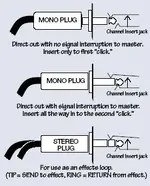R
RAK
Manufacturer - Shure, Inc
Adam P said:The insert point is wired normally closed from tip to ring. Clicking "one click" connects the Tip of your cable (TS or TRS, doesn't matter) to the ring of the insert without breaking the normal. Since the insert point's tip is normalled to the ring, and your cable's tip is touching the ring, the insert point is sending signal from the tip through the ring and to the cable, and also to the mixer's channel via its standard signal path.
If you plug the cable in all the way, it breaks the normal from tip to ring in the insert point. Now, you're sending signal from the tip of the insert to the tip of the cable. However, since the normal is now broken, no signal is being sent to the ring of the insert point and, consequently, to the rest of the channel strip of the mixer.
Whether or not you're using TS or TRS cables is inconsequential. Either way, you're only using the Tip and Sleeve connectors, and the signal will always be unbalanced.
So where is your sleeve (ground) connected?
As for your second paragraph, I believe I already pointed that out, although not in the techincal terms you used.
And your third paragraph, of course it's unbalanced.
So explain to me this? What's the difference between plugging in a TRS cable to one click, and a TS cable all the way? absolutley nothing right? I think we agree on that.
I was commenting on plugging a TS cable in all the way versus plugging it in 1 click. I think we basically said the same thing but in different ways. As I said earlier, if you do plug it in all the way, you'd have to return the signal from the aardvark outputs back to the behringer, (since you've broken the normal, as you put it), if you wanted to see it back at the behringer
Chief, I figured it was that -10/+4 issue. Sorry you can't update your software. Poor design on the part of aardvark if you ask me, but glad you're going to be able to make it work. Good luck with the Mod, and I hope you're happy with it.



 I found the problem, and am taking necessary steps to fix it i.e the mod that tarnationsauce posted. and now I'll let you guys duke the rest of it out.
I found the problem, and am taking necessary steps to fix it i.e the mod that tarnationsauce posted. and now I'll let you guys duke the rest of it out.